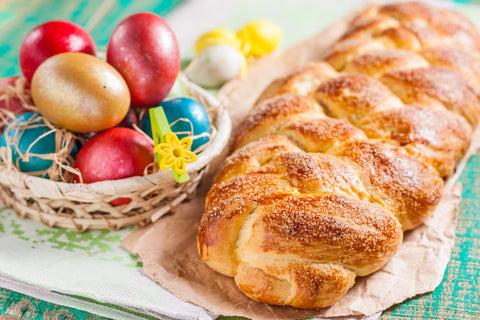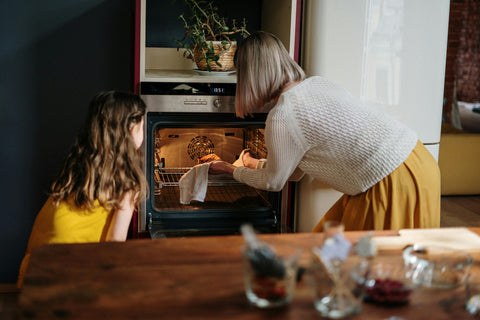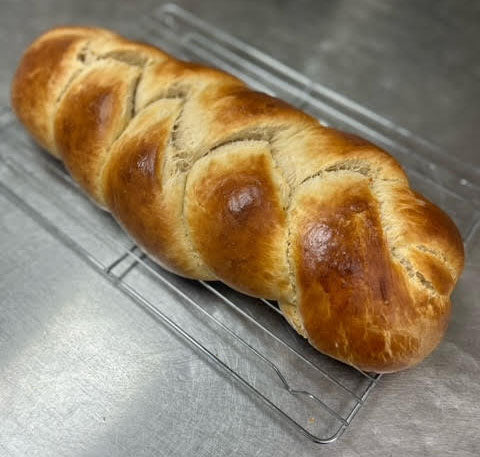Easter Is Fast Approaching And That Provides You With The Perfect Opportunity To Bake An Easter Loaf

Religious celebrations always seem to have a strong link with food, be that Christmas, Easter or Ramadan.
Whilst many people of a religious persuasion will primarily be focused on the symbolism and meaning of the Easter Celebrations, for the avid baker Easter also presents an opportunity to bake something, that little bit different, which you may not consider throughout the rest of the year - The Easter Loaf.
This post aims to provide you with a proven Easter Loaf recipe, one that will ensure your Easter Loaf really stands out and proves to be a huge success with any friends, family or guests that visit you during the holiday festivities.
How To Make The Perfect Easter Bread
Easter Bread is appealing both to the taste buds and to the eyes. It’s not just the ingredients or the baking process which is essential to the creation of the perfect Easter Loaf, many people fall into the trap of not leaving sufficient time for the dough to rise, there is no rush, so take your time and reap the rewards afterwards.
Ingredients
11g packet active dry yeast
720g Nelstrops Strong White flour or Nelstrops 100% Cheshire white flour plus more for the work surface and kneading
135g sugar 305ml milk
84g unsalted butter, plus more for greasing the bowl
11g fine salt
2 large eggs, lightly beaten
Topping
30g flaked almonds
1 tablespoon sugar nibs
1 beaten egg
Step 1 - Take about ⅓ of a cup of warm water, somewhere in the region of 40 degrees C, and pour it into the bowl of your stand mixer. Slowly wish in your yeast, 1 tablespoon of the flour and one tablespoon of the sugar. The mixture will slowly bubble up over a period of 5 to 10 minutes, and it is this bubbly texture that you are waiting for.
Step 2 - While you are waiting for the bubbly texture to form, you can heat the milk over medium heat in a small-sized saucepan. Watch closely for bubbles to form in the milk around the edges of the saucepan. Provided you have chosen the right heat, this should take about 6 minutes. Once the bubbles have appeared, then remove the pan from the heat. Then stir in the butter and rest of the sugar and the salt. Finally set aside this mixture to cool for about 10 minutes.
Step 3 - Find and then attach the paddle attachment to your mixer, and then using a slow to medium speed, pour the milk mixture you created in step 2 into the yeast mixture, before adding two beaten eggs. Take your time, slowly mixing in the rest of your Nelstrops Flour, and keep beating until a soft dough forms.
Once the dough has formed, increase the speed of the mixer to medium-high, and keep beating. Your aim is to get to the point where the dough begins to pull away from the sides of the bowl, and starts forming a ball. Another way to identify that you are ready to move forward to the next step is that the dough will become sticky.
Step 4 - Now is the time for some physical labour! Remove the dough from the bowl, and place it onto a flat surface that you have lightly floured. Begin to knead the dough, adding more flour as required. After approximately five minutes, you should get a smooth and elastic texture. Now place the dough in a lightly buttered large bowl, and then cover the bowl.
Place the bowl in a warm area of the kitchen, in order to allow it to rise. This should take anywhere between 60 and 90 minutes - remember to be patient, this is potentially the most important part of the process. During that period of time, the dough should double in size.
Step 5 - Place some parchment paper on your baking tray. Flatten your dough before placing it on a lightly floured surface, and cutting it into 3 equal parts. Roll out each of the three pieces into a 16-inch long rope. Then take your ropes and put them onto your baking sheet. Connect all three ropes at one end, and then braid them. When you get to the end tuck the last ends of the ropes under to create a long loaf. Once again leave the loaf to rise once again, typically for another hour.

Step 6 - The final part of the process involves preheating your oven to 180 degrees C.
Use the remains of the unbeaten egg to coat the full length of the loaf. Generously sprinkle your almonds and nonpareils along the entire length of the loaf, with the aim of getting the majority down the middle of the loaf. Place the loaf in the oven, until the bread goes a dark golden brown colour.
Another test is to tap on the loaf, if it is ready then it will sound hollow when tapped. The baking process should take between 50 and 60 minutes. Once it is ready, remove the loaf from the oven and let it cool down for about 30 minutes, also ensuring that any family members do not try and steal a slice before it is completely ready!
Please Click Here To Visit Our Online Shop >>

